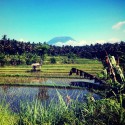Rice, to the Balinese, is more than just an important food source, it is an integral part of the Balinese culture. The mild climate, the local mountain lakes and the fertility of the soil make the island ideal for rice production.
At the beginning of planting time, after the water buffalloes walk the rice fields several times to prepare them, they press a hole in the ground to make the rice seed drop. All this is done in a special nursery in a small corner of the paddy fields. Out of the rice seeds grow small stems of rice that later will be changed to the ploughed rice fields. The rice farmer stands hours for hours bent over the rice paddy to plant the rice in long rows in the mud. During the growth, the water level is increased. The rice can grow well and ripen to beautiful, green rice fields. When the plants are fully grown they let the water out from the rice fields. Now the stalks are yellow and can be harvested. The rice is ready after 3 months. On Bali nowadays it takes three harvests per year when they use fertilizer.
Before planting, throughout growing time and at harvesting, ceremonies are held and offerings are presented to Dewi Sri, the goddess of rice. In the middle of rice fields you often find little shrines with neatly presented offerings for Dewi Sri.
From May 1 to June 30 the Rice Harvest Festival is held in various places in Bali to celebrate the end of the harvest season.
The most beautiful rice fields can be found in Tirta Gangga, around Jatiluwih, just north of Ubud and around Sidemen and Selat (southeast near Candidasa).





